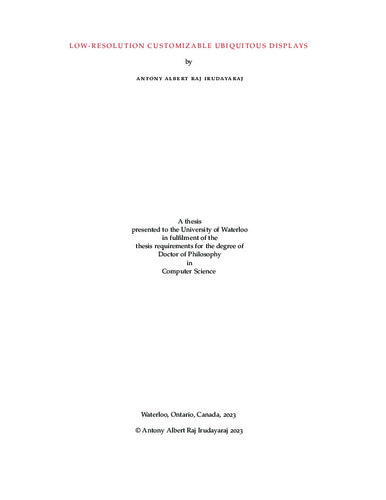| dc.contributor.author | Irudayaraj, Antony Albert Raj | |
| dc.date.accessioned | 2023-09-22 13:37:31 (GMT) | |
| dc.date.available | 2023-09-22 13:37:31 (GMT) | |
| dc.date.issued | 2023-09-22 | |
| dc.date.submitted | 2023-09-15 | |
| dc.identifier.uri | http://hdl.handle.net/10012/19914 | |
| dc.description.abstract | In a conventional display, pixels are constrained within the rectangular or circular boundaries of the device. This thesis explores moving pixels from a screen into the surrounding environment to form ubiquitous displays. The surrounding environment can include a human, walls, ceiling, and floor. To achieve this goal, we explore the idea of customizable displays: displays that can be customized in terms of shapes, sizes, resolutions, and locations to fit into the existing infrastructure. These displays require pixels that can easily combine to create different display layouts and provide installation flexibility. To build highly customizable displays, we need to design pixels with a higher level of independence in its operation. This thesis shows different display designs that use pixels with pixel independence ranging from low to high.
Firstly, we explore integrating pixels into clothing using battery-powered tethered LEDs to shine information through pockets. Secondly, to enable integrating pixels into the architectural surroundings, we explore using battery-powered untethered pixels that allow building displays of different shapes and sizes on a desired surface. The display can show images and animations on the custom display configuration. Thirdly, we explore the design of a solar-powered independent pixel that can integrate into walls or construction materials to form a display. These pixels overcome the need to recharge them explicitly. Lastly, we explore the design of a mechanical pixel element that can be embedded into construction material to form display panels. The information on these displays is updated manually when a user brushes over the pixels. Our work takes a step forward in designing pixels with higher operation independence to envision a future of displays anywhere and everywhere. | en |
| dc.language.iso | en | en |
| dc.publisher | University of Waterloo | en |
| dc.subject | ubiquitous displays | en |
| dc.subject | customizable displays | en |
| dc.title | LOW-RESOLUTION CUSTOMIZABLE UBIQUITOUS DISPLAYS | en |
| dc.type | Doctoral Thesis | en |
| dc.pending | false | |
| uws-etd.degree.department | David R. Cheriton School of Computer Science | en |
| uws-etd.degree.discipline | Computer Science | en |
| uws-etd.degree.grantor | University of Waterloo | en |
| uws-etd.degree | Doctor of Philosophy | en |
| uws-etd.embargo.terms | 0 | en |
| uws.contributor.advisor | Vogel, Daniel | |
| uws.contributor.advisor | Abari, Omid | |
| uws.contributor.affiliation1 | Faculty of Mathematics | en |
| uws.published.city | Waterloo | en |
| uws.published.country | Canada | en |
| uws.published.province | Ontario | en |
| uws.typeOfResource | Text | en |
| uws.peerReviewStatus | Unreviewed | en |
| uws.scholarLevel | Graduate | en |

